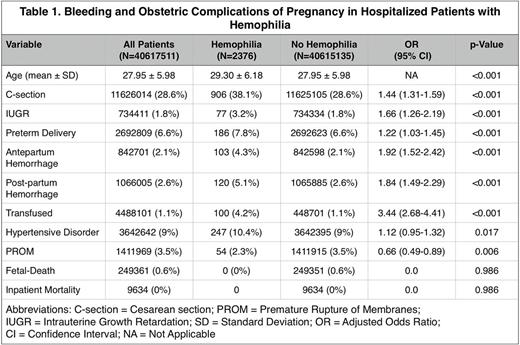Abstract
Introduction: Hemophilia is a rare disease, even more so among women. Case reports and retrospective studies suggest that women with hemophilia have increased risk of bleeding and obstetric complications however the exact burden of this remains unknown. By analyzing the Nationwide Inpatient sample database (NIS) of Healthcare Cost and Utilization Project(AHRQ), we attempted to identify pregnant women with hemophilia A or B and compared their outcome and Obstetric complications with pregnant women who did not have a diagnosis of hemophilia.
Method: By using NIS database 2003-2011, we identified the number of obstetric hospitalization, deliveries and caesarean deliveries in women between the age group 18-50 years. Patients hospitalized with Hemophilia A or B were also identified (ICD-9 286.0, 286.1 respectively). We then compared pregnancy related complications for women with and without Hemophilia. Multivariate logistic regression analysis was used to obtain adjusted odds ratio (OR).
Results: The total number of obstetric hospitalizations was 42.31 million of which 2415 were Hemophilia A or B. After adjusting for potential confounding factors, compared with patients without Hemophilia, those with hemophilia had significantly higher caesarian section rate [37.5% vs 28%, OR 1.44(CI 1.31-1.59)], intrauterine growth retardation [3.2% vs 1.8%, OR 1.66(CI 1.26-2.19)], preterm deliveries [7.9% vs 6.6%, OR 1.22(CI 1.03-1.45)], antepartum hemorrhage [4.5% vs 2%, OR 1.92(CI 1.52-2.42)], postpartum hemorrhage [5% vs 2.6%, OR 1.84(CI 1.49-2.29)] and transfusion rate [4.2% vs 1.1%, OR 3.44(CI 2.68-4.41)] . Conversely, the incidence of premature rupture of membranes in the hemophiliac group was less as compared to the control group. Inpatient fetal and maternal mortality was found to be zero. The frequencies of the above outcomes with Odds Ratio are reported in Table 1.
Conclusion: The overall risk of cesarean section, intrauterine growth retardation, preterm deliveries, risk of transfusion and antepartum and postpartum hemorrhage was higher in pregnant women who have hemophilia. This cross sectional study would help to understand the magnitude of these complications so that they could be managed optimally during antenatal period. Further studies are needed to examine these findings in relation to severity of disease, medications used and the presence of other comorbidities.
No relevant conflicts of interest to declare.
Author notes
Asterisk with author names denotes non-ASH members.


This feature is available to Subscribers Only
Sign In or Create an Account Close Modal